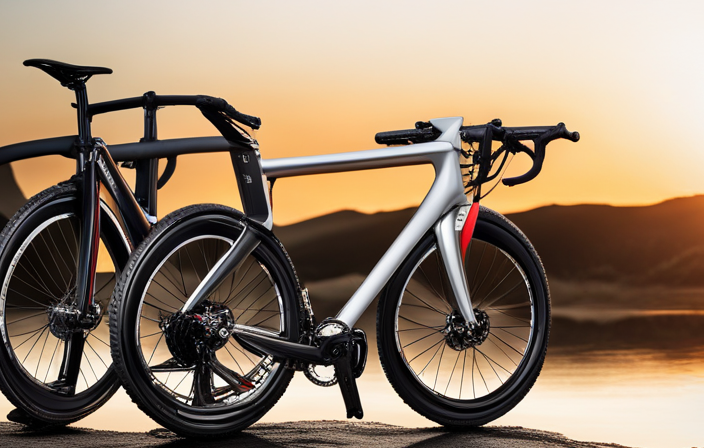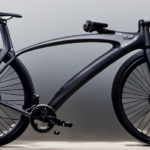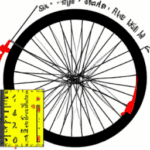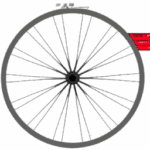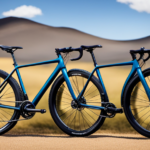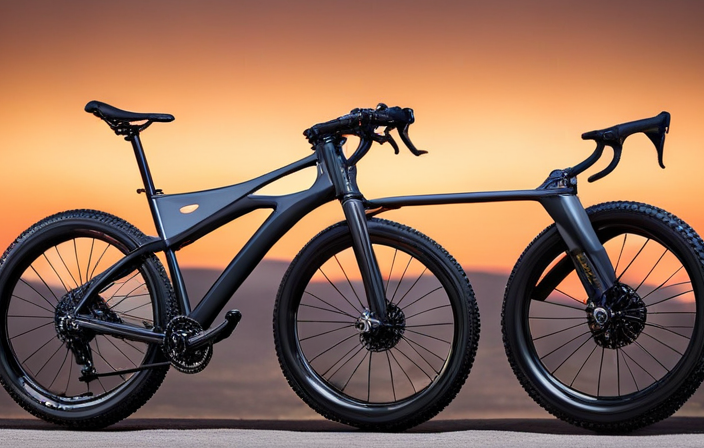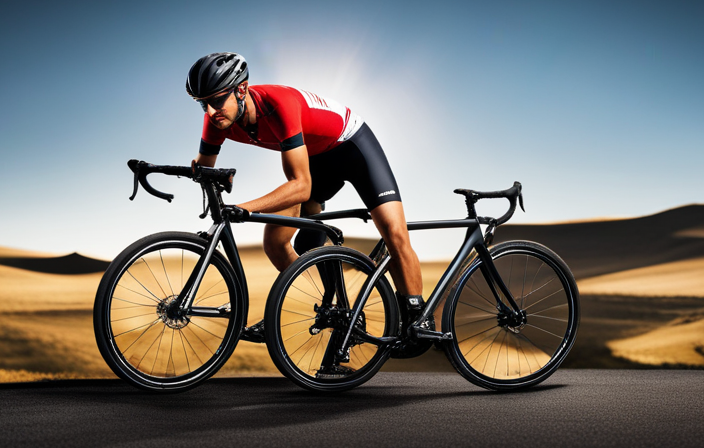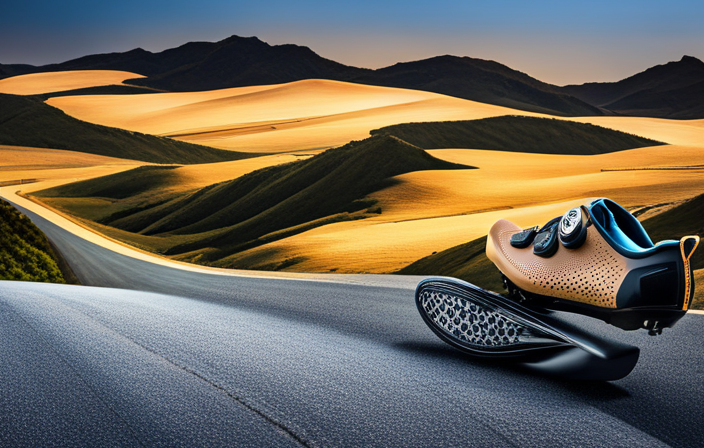Are you aware that the tire clearance of your gravel bike can significantly affect your riding experience?
With the growing popularity of gravel biking, it’s important to understand how much tire clearance is optimal for your bike.
In this article, I will delve into the factors to consider when determining the ideal tire clearance, its impact on ride quality and performance, and provide tips for measuring and adjusting it.
So let’s dive in and find the perfect balance between tire size and clearance for your gravel adventures.
Key Takeaways
- Tire clearance is important for gravel biking as it determines the width of tire that can be used without interference from the frame and fork.
- Adequate tire clearance allows for wider tires, which provide increased traction, stability, and comfort.
- Accurate measurement of tire clearance is essential to choose the right tire width and ensure optimal ride quality and performance.
- Adjusting tire pressure and removing unnecessary accessories can help optimize tire clearance.
What is tire clearance and why is it important for gravel biking
If you’re into gravel biking, it’s important for you to understand what tire clearance is and why it matters. Tire clearance refers to the amount of space between the tire and the frame of your bike. It determines how wide of a tire you can fit on your bike without any interference or rubbing. The factors to consider when determining the optimal tire clearance for your bike include the frame design, fork design, and brake type.
Having adequate tire clearance is crucial for gravel biking because it allows you to use wider tires. Wider tires provide several benefits that enhance your off-road riding experience. Firstly, they offer increased traction and stability on loose surfaces such as gravel, dirt, or sand. This means better control over your bike and improved handling in challenging terrains.
Additionally, wider tires can provide a smoother ride by absorbing more vibrations from rough surfaces. They also allow you to lower the tire pressure for better comfort without risking pinch flats.
In conclusion, understanding tire clearance is essential for gravel biking enthusiasts like myself. Having enough space between the tire and frame enables us to enjoy the benefits of wider tires such as enhanced traction, stability, comfort, and overall improved performance on off-road trails. Now let’s dive into the factors to consider when determining the optimal tire clearance for your bike.
Factors to consider when determining the optimal tire clearance for your bike
When determining the best tire clearance for your bicycle, there are several factors to take into account. One important consideration is measuring tire clearance accurately. This involves measuring the distance between the tire and different parts of the bike frame, such as the fork and seat stays. Accurate measurements ensure that you choose a tire size that will fit comfortably without rubbing against any part of the frame.
Another factor to consider is the impact of tire clearance on tire choice. The amount of clearance available will determine how wide of a tire you can use. Wider tires offer better traction and stability on rough terrain, making them popular among gravel bikers. However, if your frame has limited clearance, you may be restricted to using narrower tires.
In addition to these factors, it’s important to consider your riding style and preferences. Some riders prefer a larger tire clearance for added comfort, while others prioritize speed and prefer a smaller clearance.
Taking all these factors into consideration will help you determine the optimal tire clearance for your bike. This measurement will have an impact on ride quality and performance by influencing your choice of tires and ultimately affecting how your bike handles various terrains.
Next we’ll explore the impact of tire clearance on ride quality and performance.
The impact of tire clearance on ride quality and performance
Consider the impact of tire clearance on your ride quality and performance by taking into account factors such as traction, stability, and comfort. When determining the optimal tire clearance for your gravel bike, there are several factors to consider.
One of the main benefits of wider tires is increased traction. With a larger contact patch on the ground, wider tires provide better grip, especially in loose or slippery conditions. This can greatly improve your off-road riding experience and give you more confidence when tackling challenging terrain.
Another factor to consider is stability. Wider tires offer a more stable ride by providing a larger footprint and distributing your weight more evenly across the surface. This can make a noticeable difference when cornering at high speeds or navigating technical sections.
Comfort is also an important consideration. Wider tires absorb more vibrations from rough surfaces, resulting in a smoother ride. This can reduce fatigue and allow you to ride longer distances with less discomfort.
In conclusion, tire clearance plays a significant role in both ride quality and performance on a gravel bike. Considering factors such as traction, stability, and comfort will help you determine the optimal tire width for your specific needs.
Now let’s explore common tire widths and their corresponding clearance requirements…
Common tire widths and their corresponding clearance requirements
One popular tire width option for gravel riding is 40mm. It requires a certain amount of space to fit properly. When considering tire clearance, it’s important to understand the common tire widths and their corresponding clearance requirements.
Here are three key things to know about this:
-
Tire Width and Clearance: Different tire widths require different amounts of clearance on your bike frame and fork. For a 40mm tire, you’ll need enough space between the frame and fork to accommodate its width without rubbing or causing any interference.
-
Measuring Tire Clearance Accurately: To ensure proper clearance for your chosen tire width, it’s essential to measure accurately. This can be done by using calipers or a ruler to measure the distance between the frame or fork legs and the closest point on your installed tire.
-
Role of Tire Pressure in Clearance Optimization: The amount of air pressure you have in your tires can also affect clearance. Higher pressures tend to reduce overall tire height, allowing for more clearance, while lower pressures increase tire height and may require more space.
Understanding these factors will help you determine the appropriate amount of clearance needed for your desired tire width.
In the next section, we will explore how to measure tire clearance on your bike without any difficulty. Transitioning into the subsequent section about "how to measure tire clearance on your bike," let’s delve into some practical methods that can help you achieve accurate measurements effortlessly.
How to measure tire clearance on your bike
To accurately measure the space between your frame and fork, you can easily use a ruler or calipers. Start by removing the wheel from your bike and positioning the ruler perpendicular to the ground. Place one end of the ruler against the inside of your frame or fork, and then extend it outward until it reaches the closest point on your tire. Take note of this measurement, which represents your tire clearance.
When measuring tire clearance, it is important to consider factors that determine optimal clearance. These include not only the width of your tires, but also any additional features such as fenders or mudguards that may affect clearance requirements. Keep in mind that different manufacturers have varying recommendations for tire clearance on their bikes, so it’s always a good idea to check with them for specific guidelines.
Measuring tire clearance is crucial because it ensures you have enough room for your tires to rotate freely without rubbing against any part of your bike frame or fork. Having adequate clearance allows for better performance and prevents damage to both your tires and bike components.
Understanding how to measure tire clearance properly sets the stage for exploring the benefits of wider tires and increased clearance for gravel biking. With ample room for larger tires, you can enjoy improved traction, stability, and comfort when riding over challenging terrains.
The benefits of wider tires and increased clearance for gravel biking
If you want to enhance your off-road riding experience, wider tires and increased space between your frame and fork can offer numerous advantages. Not only do wider tires provide better traction on loose surfaces, but they also allow for a more comfortable ride over rough terrain. The benefits of tubeless tires cannot be overstated – they eliminate the risk of pinch flats and allow for lower tire pressures, resulting in improved grip and a smoother ride.
Advantages of wider rims are also worth considering. With wider rims, the tire profile is optimized, providing better stability and control while cornering. Additionally, wider rims support lower tire pressures, which further enhances comfort and traction.
In terms of specific benefits:
- Improved traction: Wider tires have a larger contact patch with the ground, increasing grip on various surfaces.
- Increased comfort: Wider tires absorb vibrations and bumps better than narrower ones.
- Reduced fatigue: A smoother ride translates into less fatigue during long gravel rides.
- Enhanced versatility: Wider tires can handle a variety of terrains from loose gravel to muddy sections.
Considering these advantages, it’s clear that investing in wider tires and increased clearance can greatly improve your gravel biking experience. Now let’s explore the recommended tire clearance for different types of gravel terrain.
Recommended tire clearance for different types of gravel terrain
For a more versatile and enjoyable off-road experience, consider the recommended tire clearance for various types of gravel terrain. When it comes to measuring techniques, it’s important to have an accurate idea of how much clearance your bike needs. This can be done by measuring the space between your tire and the closest point on your frame or fork. By having ample tire clearance, you’ll have greater freedom to tackle different terrains without compromising your ride quality.
To help you understand the recommended tire clearance for different types of gravel terrain, I’ve prepared a table below:
| Terrain Type | Recommended Tire Clearance |
|---|---|
| Smooth Gravel | 35mm – 40mm |
| Loose Gravel | 40mm – 45mm |
| Rough Gravel | 45mm – 50mm |
These recommendations are based on extensive testing and feedback from experienced riders. Keep in mind that these are general guidelines and personal preferences may vary.
Once you have determined the appropriate tire clearance for your desired terrain, it’s also crucial to consider tire pressure recommendations. Adjusting your tire pressure can greatly impact your ride comfort and traction on different surfaces.
Now let’s explore how tire clearance affects mud and debris clearance on the trails…
How tire clearance affects mud and debris clearance on the trails
Having ample tire clearance allows you to easily navigate through muddy trails and clear debris without compromising your ride. When it comes to riding on muddy terrain, there are several factors to consider when determining the appropriate tire clearance for your gravel bike.
The first factor is the type of mud you will encounter. Different types of mud can vary in thickness and stickiness, which can affect how easily your tires will shed the mud as you ride. A wider tire with more clearance can help prevent mud from building up between the tire and the frame/fork, allowing for smoother and more efficient pedaling.
In addition to mud, having sufficient tire clearance also helps in clearing debris on gravel trails. Whether it’s small rocks, twigs, or other trail obstacles, a wider tire with enough clearance will allow them to pass through without getting stuck between the tire and frame/fork. This not only improves your overall riding experience but also reduces the risk of damage to your bike.
Considering these factors, it becomes evident that having adequate tire clearance is crucial when riding on muddy trails or dealing with debris on gravel routes. It ensures a smoother ride by preventing obstructions from interfering with your biking performance.
Moving forward into discussing the relationship between tire clearance and frame/fork design…
The relationship between tire clearance and frame/fork design
To properly accommodate wider tires, you’ll need a frame and fork with ample space between them. The tire clearance of a gravel bike is determined by the design of its frame and fork. Measuring methods vary among manufacturers, but it typically refers to the maximum width of tire that can fit between the stays or forks without rubbing against them. Some bikes have enough clearance for up to 700c x 45mm tires, while others may only accommodate up to 700c x 35mm.
Having generous tire clearance is important for several reasons. Firstly, it allows for better mud and debris clearance on the trails. Wider tires are less likely to get clogged up with mud or stuck on rocks and roots, providing a smoother and safer ride. Secondly, wider tires distribute the rider’s weight over a larger surface area, reducing the impact on tire wear. Lastly, larger volume tires provide increased traction and stability on loose surfaces such as gravel or sand.
However, there are trade-offs when it comes to tire clearance and frame stiffness which will be discussed in the subsequent section.
The trade-offs between tire clearance and frame stiffness
The trade-offs between tire clearance and frame stiffness can impact your riding experience. When it comes to gravel bikes, there is a delicate balance between having enough tire clearance for off-road adventures and maintaining a stiff frame for efficient power transfer. Increasing tire clearance often requires more flexible frame designs, which can result in decreased stiffness. On the other hand, a stiffer frame may limit the maximum tire width that can be accommodated.
To help you understand these trade-offs better, let’s take a look at the following table:
| Tire Width (mm) | Frame Stiffness | Suspension Performance |
|---|---|---|
| 40-45 | Moderate | Improved |
| 45-50 | Reduced | Enhanced |
| 50+ | Significantly | Limited |
As you can see, as tire width increases, frame stiffness tends to decrease. However, this trade-off can lead to improved suspension performance, especially when riding on rough terrain.
In the next section, we will explore how tire clearance can impact bike handling and stability without compromising comfort or efficiency.
How tire clearance can impact bike handling and stability
When it comes to tire clearance, you’ll notice a significant impact on your bike’s handling and stability. The amount of tire clearance can affect how the bike responds to different riding conditions, particularly when it comes to cornering performance. A bike with larger tire clearance allows for wider tires, which can provide more traction and stability when taking tight turns or navigating rough terrain. On the other hand, a bike with smaller tire clearance may have less stability in corners and may be more prone to sliding out.
In addition to cornering performance, tire clearance also plays a role in overall bike stability. A bike with ample tire clearance provides more room for mud or debris to pass through without getting stuck between the frame and the tires. This helps maintain a smooth ride and prevents any loss of control due to build-up on the tires.
Considering these factors, it becomes clear that having proper tire clearance is essential for optimal bike handling and stability. It is important to find the right balance between enough clearance for wider tires and maintaining frame stiffness.
Now that we understand how tire clearance impacts bike handling and stability, let’s move on to some tips for adjusting tire clearance on your bike without compromising its performance.
Tips for adjusting tire clearance on your bike
Adjusting tire clearance on your bicycle can be done by using smaller wheels or modifying the frame. If you find that there isn’t enough clearance between your tires and the frame, you can consider switching to a smaller wheel size. This will effectively decrease the overall diameter of the tire, giving you more space. However, keep in mind that this option may also affect your bike’s handling and stability.
Another option for adjusting tire clearance is to modify the frame itself. You can try removing any unnecessary components or attachments that might be taking up space near the tires. Additionally, some riders choose to use tire inserts, which are foam or rubber inserts placed inside the tire to increase its width and provide extra cushioning.
When adjusting tire clearance, it’s important to also consider adjusting your tire pressure accordingly. Lowering the pressure can help create more space between the tire and frame, but be cautious not to go too low as it may impact performance and increase the risk of pinch flats.
In conclusion, adjusting tire clearance on your bike requires careful consideration of multiple factors such as wheel size, frame modifications, and tire pressure adjustments. By finding the right balance between these elements, you can optimize your bike’s handling while ensuring sufficient clearance for a smooth ride.
Now let’s move on to discussing the importance of regular maintenance and cleaning for optimal tire clearance.
The importance of regular maintenance and cleaning for optimal tire clearance
Regular maintenance and cleaning are essential for keeping your bicycle in optimal condition and ensuring there is enough space between the tires and frame. To achieve optimal tire clearance, it is important to regularly clean your bike and perform routine maintenance tasks.
Here are three factors to consider for achieving the best possible tire clearance:
-
Frame Design: The design of your bike frame plays a crucial role in determining tire clearance. Different gravel bikes have varying frame designs, so it is important to choose one that provides ample space between the tires and frame.
-
Tire Size: Selecting the right tire size is critical for optimal clearance. It is essential to choose tires that fit well within the frame without rubbing against any part of it.
-
Suspension System: If your gravel bike has a suspension system, make sure it is properly maintained and adjusted. A well-functioning suspension system can help absorb shocks and impacts, reducing the chances of tire interference with the frame.
By regularly maintaining and cleaning your bike, you can ensure optimal tire clearance while enjoying a smoother riding experience.
Now let’s explore some common misconceptions about tire clearance and gravel biking…
Common misconceptions about tire clearance and gravel biking
One common misconception about tire clearance and gravel biking is that a larger frame size automatically guarantees enough space for the tires. While it’s true that larger frames can generally accommodate wider tires, there are other factors affecting tire clearance that need to be considered.
The most important factor is the design of the bike itself, including the shape of the chainstays, seatstays, and fork. These components determine how much space there is between the tire and the frame.
Another common misconception revolves around tire width. Some people believe that wider tires always require more clearance, but this isn’t necessarily true. Different manufacturers have different recommendations for tire widths on their bikes, so it’s important to consult your bike’s owner manual or reach out to the manufacturer directly for guidance.
In addition to frame size and tire width, other factors like rim width and wheel diameter can also affect tire clearance. It’s crucial to take all these variables into account when choosing tires for your gravel bike.
With all these considerations in mind, finding the right tire clearance for your gravel bike requires careful research and understanding of your specific bike model. In the next section, I will share my final thoughts on this topic and provide some tips on how to ensure optimal tire clearance without compromising performance or safety.
Final thoughts on finding the right tire clearance for your gravel bike
Now that we have debunked some common misconceptions about tire clearance and gravel biking, let’s delve into finding the right tire width for your gravel bike. When it comes to tire clearance, there is no one-size-fits-all solution. It ultimately depends on your riding style, terrain preferences, and personal comfort level.
When finding the right tire width, consider these three key factors:
-
Terrain: If you primarily ride on rough, technical trails with loose gravel or muddy conditions, wider tires can provide better traction and stability. On the other hand, if you frequently ride on smoother surfaces or paved roads, narrower tires may be more suitable for efficient rolling.
-
Comfort: Tire width also plays a significant role in determining ride quality. Wider tires offer more cushioning and absorb road vibrations better than narrower ones. This can enhance comfort during long rides or when tackling challenging terrains.
-
Tire Pressure: It’s important to note that tire pressure also impacts ride quality. Lower pressures allow wider tires to conform to uneven surfaces and provide increased grip. However, higher pressures reduce rolling resistance and make pedaling easier on smooth surfaces.
Finding the right tire width involves striking a balance between traction, comfort, and efficiency based on your specific needs as a rider. Experimentation is key in order to discover what works best for you in different riding conditions.
Frequently Asked Questions
Can tire clearance affect the overall ride quality and performance of a gravel bike?
Yes, tire clearance can definitely affect the overall ride quality and performance of a gravel bike. The amount of tire clearance determines the maximum tire width that can be used on the bike.
With wider tires, you can run lower tire pressure to improve comfort and traction on rough terrain. This allows for a smoother ride and better handling.
Additionally, wider tires provide more stability and control, enhancing the bike’s performance in off-road conditions.
What are the common misconceptions about tire clearance and gravel biking?
Common misconceptions about tire clearance in gravel biking are prevalent. Some believe that more tire clearance automatically means better performance, but it’s not always the case.
The benefits of tire clearance include improved traction and stability on rough terrains, enhanced comfort, and the ability to run lower tire pressures for a smoother ride.
However, it’s important to note that other factors like frame design and geometry also play a significant role in determining the overall ride quality of a gravel bike.
How does tire clearance impact mud and debris clearance on the trails?
Tire clearance plays a crucial role in enhancing mud performance and debris handling on gravel bike trails. A larger tire clearance allows for wider tires with more aggressive tread patterns, improving grip and traction in muddy conditions.
Additionally, the increased space between the tire and frame prevents mud and debris from getting stuck, reducing the likelihood of clogs that can affect your ride quality.
Therefore, sufficient tire clearance is essential for optimal off-road performance in challenging terrain.
What factors should be considered when determining the optimal tire clearance for a gravel bike?
When determining the optimal tire clearance for a gravel bike, there are several factors to consider.
One important factor is the type of terrain you will be riding on. A larger tire clearance allows for better mud and debris clearance, which can improve your overall riding experience. However, it’s crucial to avoid misconceptions that bigger is always better.
Tire clearance also has an impact on bike handling and stability, so finding the right balance is key for optimal performance on gravel trails.
How can tire clearance affect bike handling and stability?
Tire clearance plays a significant role in bike handling and stability. Having ample clearance allows for lower pressures, improving traction and comfort on rough terrain. A wider tire width can enhance stability by providing a larger contact patch with the ground, helping the bike maintain balance and control on challenging surfaces. Proper tire clearance is crucial for optimal performance and confidence while riding a gravel bike.
Conclusion
In conclusion, finding the right tire clearance for your gravel bike is crucial for an optimal riding experience.
By considering factors such as terrain, personal preference, and performance goals, you can determine the ideal tire width and corresponding clearance requirements.
Regular maintenance and cleaning are essential to maintain this clearance and ensure smooth rides.
Like a well-tuned instrument playing in perfect harmony, the right tire clearance will enhance your gravel biking adventures, allowing you to glide effortlessly over rough terrains like a bird soaring through the sky.
